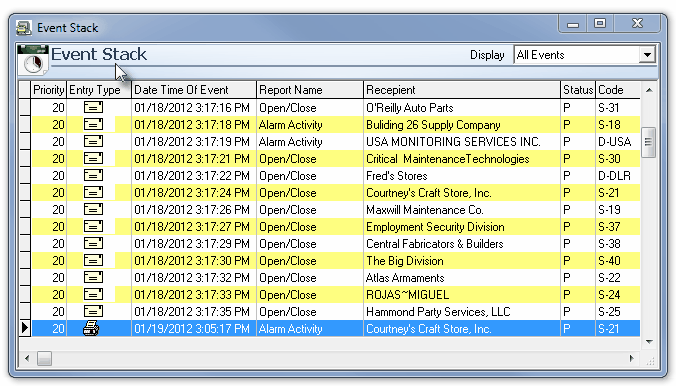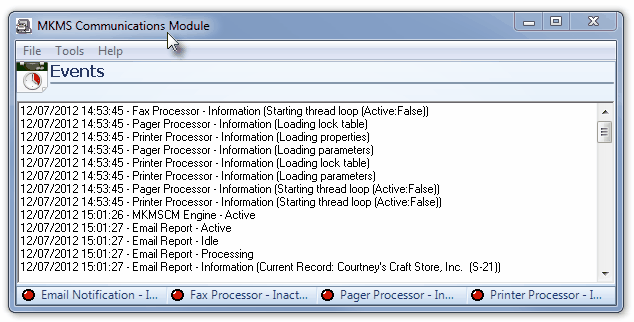| □ | The MKMS CM Communications Module provides the following functionality: |

Communication Module dialog
| • | Fax or Email a specified Report to a designated Subscriber or Dealer on a specific Day and Time of each week or each month. |
| • | The Communication Module Events are: |
| • | Email or Page a Contact when a specific Zone is received. |
| • | Email or Page a Technician with all signals received when (s)he is in the field testing an Account. |
| • | When one of these items is in this Events Stack and it reaches the designated Date and Time an Email, Fax, or Page event must occur, it will proceed automatically with that action (faxing, emailing, report printing, and/or paging). |
| □ | The interface between MKMSCM and MKMS is based on a set of database tables. |
| • | MKMS is in control of the create, modify, and/or configuration entries. |
| • | MKMSCS and SPA will generate message entries based on that configuration. |
| • | MKMSCM (and/or MKMSCMSrv) will process every message created and reschedule (if required). |
| • | Automatic Faxing, Printing and E-Mailing of Reports based on Date, Time and Frequency rules established by the user. |
| • | Automatic Event (Alarm Signal) Notification through Paging (Digital, Internet and Alpha) sent to any or all of the following: |
| • | Technicians to notify them of signals received during an Alarm System Testing Procedure. |
| • | Dealers - to notify them of the occurrence of (specifically requested) Alarm Events. |
| • | Automated Report Printing. |
| • | The MKMSCS Central Station Monitoring application measures the time that an Operator takes to respond to (start processing) an Active Signal. |
| • | If the Operator does not respond to an Active Signal within the established time period, a Predefined Message will be sent to the Communications Module which will notify (via Pager or Email) the appropriate person(s). |
| □ | The Communications Module functions internally as follows: |
| • | MKMSCM.EXE is the application used to configure the Communications Module and may also process some, or all of the requests for the scheduled Faxing and E-Mail requirements, interfaces with external applications such as WinFaxPro and your Web connection, prints the Scheduled Reports, and handles the Alarm Event paging triggers. |
| • | MKMSCMSrv is the Windows® Service that may process any, or all of these functions instead of using MKMSCM to do so. |
| • | MKMS.EXE is your MKMS application where you must establish the "communication rules" for the Communications Module to follow. |
| □ | The Communications Module application has two screen sections: |
| 1. | An Event Stack which shows the pending and in-progress events. |

Communication Module Event Stack
| 2. | The Events Message Board which shows the significant events that have occurred. |

Communication Module dialog
| □ | What's Next? To start using the Communications Module, complete the information (as required) which is explained in the following chapters: |
| • | Pager Services are entered to identify the Modem Telephone numbers of Alpha Paging Services. |
| • | Predefined Messages are entered to assist in designing what Alpha and E-Mailed messages are transmitted. |
| • | Dealer Information relating to Pager and E-mail Information must be entered. |
| • | Each Subscriber's Scheduled Report Frequency should be defined - if appropriate - on the Central Station Data Form. |
| • | Employee Information relating to Paging is defined. |






